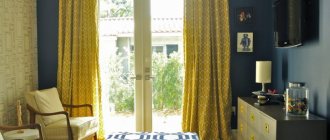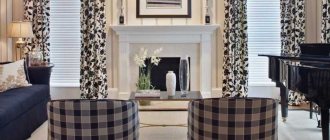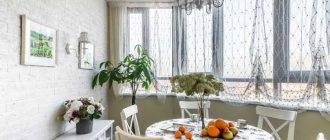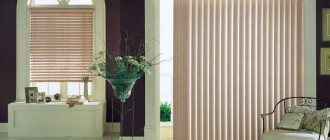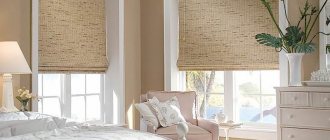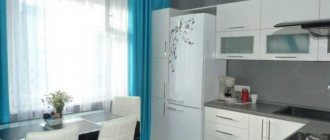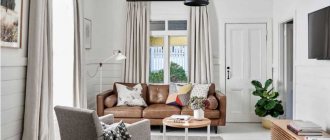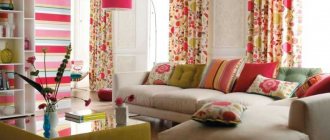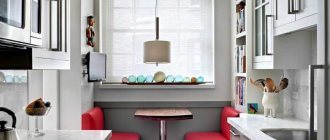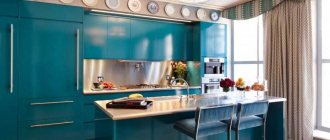Selecting a curtain model
There are several varieties of the most common types of curtains for the kitchen: Roman, Japanese, roller, coffee, classic models. Their photos can be easily found on the Internet.
Roman curtains
A sheet of fabric that can be raised and lowered by a lifting mechanism, allowing light to pass through or shading the kitchen. When lifted, the Roman blind forms uniform accordion folds.
Typically, only the bottom half of the canvas is raised. But you can buy a ready-made model that rises completely.
A Roman blind either covers the entire window opening or is attached to the window sash and leaves the window sill open. As a rule, several curtains are hung on wide windows.
Almost all fabrics are suitable for making kitchen curtains, with the exception of pressed and stretched fabrics. Roman blinds are more suitable for narrow windows.
Austrian curtains for the kitchen
This option is a successful hybrid of Roman and French curtains, as they combine simple design control and lush drapery. With a simple movement of the hand, the light canvas covering the window opening turns into luxurious festoons - gathered semicircular folds. Austrian curtains look sophisticated and elegant.
Despite all their pomp, they take up very little space. If desired, transparent or thick fabrics can be used to make such curtains. This option does not involve the use of tulle or other decorative window decorations. Austrian curtains will appeal to gentle and romantic people; they will help make the kitchen elegant and stylish.
Coffee curtains
These are short curtains up to the windowsill. They are suspended on a telescopic cornice, which is attached to the window frame from the middle of the window.
Note!
Apron for the kitchen: TOP-130 photos of design and modern designKitchen in minimalist style: new designs for minimalist kitchens. Choice of colors, furniture and additional decor + 120 photos
Kitchen in the Art Deco style - TOP-190 photos of kitchen interiors in the Art Deco style + DIY stylish furnishing ideas
Advantages. These curtains look very comfortable due to their small size. They are easy to clean and do not hide the kitchen space.
Panel (Japanese) curtains
These are sliding fabric panels. They move along guide rails, like wardrobe doors. Well suited for kitchens with balcony doors, large windows and easy to use. They can be controlled remotely, which is important if the windows are high enough.
The panels are easy to clean thanks to antistatic impregnation. Their usual length reaches the floor. Therefore, they visually raise the ceiling. The absence of folds does not overload the interior, which is important for small kitchens.
Features of curtains for the kitchen
Before choosing a specific solution, you need to understand the main features of the products. This will help you immediately discard unsuitable varieties and ensure that you select high-quality curtains that will suit the decor and retain their attractiveness for a long time. It is important to remember the following:
- It is best to choose materials that do not absorb odors and are resistant to grease splashes. Usually these are natural fabrics with the addition of synthetics, which provides good performance characteristics.
- Consider the location of the kitchen. If the window faces south or east, the sun will shine most of the day. Sufficiently dense fabrics that can shade the room are suitable here. Another requirement for the manufacturing material is resistance to fading; if you hang a low-quality option, it will lose color in literally a year and a half.
- Choose unpretentious materials that can be washed frequently. You should not use varieties that require special washing conditions or are dry cleaned. Ideally, use a fabric that dries quickly.
- Interior design is also of great importance. You can use curtains for the 2021 kitchen in both modern and traditional styles, if it suits the overall design. The window must fit harmoniously into the decor, otherwise it will not look very good. Color design is selected individually in each specific case.
By the way! Many manufacturers offer special fabrics for kitchen curtains. They are impregnated with a special composition, so they do not absorb dirt and are resistant to fire.
When choosing curtains for a kitchen with a balcony, keep in mind that the lighting in the room is much worse. There is no point in hanging dense elements; it is important to ensure normal light penetration, otherwise you will need to constantly turn on the lighting.
Classic curtains made of light fabrics
Classic style is our most popular design. Assembly is most often done using curtain tape of various types. They are hung from the cornice on loops, hooks or rings using alligator clips.
Classic, versatile and suitable for all modern kitchens. Unlike roller blinds, panel curtains and blinds, they have folds, creating a comfortable interior.
Thanks to the abundance of fabrics, accessories for curtains, and the ability to choose the length of the curtain, you can not only create a unique design, but also hide pipes, a balcony door or a heating radiator.
Decorating a kitchen window with cafe curtains
Cafe curtains are most often used to decorate windows in small spaces, so they are ideal for a compact kitchen. Such curtains are attached to a thin strip, which can be placed in any part of the window opening - for example, in the middle, or higher. After installation, the upper part of the window remains open, but if desired, you can install a lambrequin made of the same fabric as the curtains.
The curtain itself is attached to the curtain rod in different ways: on hinges, on a drawstring, on hooks and braid, on ties, on eyelets and on rings. The lower part of the curtains can be decorated with scallops, tassels or decorative tiebacks. Cafe curtains look very cute and are perfect for installation in a kitchen, the interior of which is made in Provence, shabby chic, or retro styles.
Fabric color and pattern
Most often, curtains are selected in accordance with the color of the walls, the tone of the kitchen interior or the colors of kitchen textiles: chair upholstery, fabric of chair cushions and towels.
The most universal color of curtains is white and its shades. If there is not enough sunlight in the kitchen, choose curtains in warm colors. For example, cream or yellow colors.
- The fabric pattern should echo the pattern of wallpaper, flooring, rugs, wall decorations and other textiles in the kitchen.
- A large pattern visually reduces the space. Therefore, for small kitchens it is better to choose curtains with one or several different patterns.
- If the ceiling is low, choose curtains with vertical stripes or a diamond pattern. If the kitchen is small and narrow, then Roman and roller blinds will make it appear larger.
- For classic kitchens, curtains with a traditional print, such as a checkered pattern or a floral or heraldic pattern, are suitable.
What styles of curtains for the kitchen are there?
Despite their small size, modern kitchens provide ample space for experimentation. Here you can use any curtains: short transparent curtains made of light fabrics, stylish roller blinds in cool tones or ordinary discreet blinds. The main thing is that they do not interfere with the work process and have a simple design and a minimum of decor.
Classic style
An indispensable companion of the classic style is a cozy atmosphere and elegance of forms. If you want to choose curtains for a kitchen decorated in the style of classicism, you should pay attention to discreet curtains without unnecessary variegation. In small spaces, elegant short curtains or beautiful thread designs are appropriate. Two-layer combinations of simple thin curtains with elegant draperies made of organza or tulle will fit perfectly into the interior.
For large rooms in which the kitchen and living room create a studio, curtains can be complemented with lambrequins. Moreover, in a classic kitchen, lambrequins can have the most complex styles. After all, they do not reduce the functionality of the room, and it looks luxurious and elegant.
East style
Depending on the chosen interior - Japanese, Chinese or Moroccan, kitchen curtains can have very different designs. For example, they come from organza, which is weightless and allows maximum light into the room. Lush curtains made of shiny fabrics, decorated with various oriental elements: hieroglyphs, exotic patterns, exquisite patterns, fringe, would look appropriate in an oriental interior.
You can safely choose multi-level curtains embroidered with gold for your kitchen, or modern photo curtains with bright patterns, intricate arabesques or floral motifs. Another interesting option for window decoration is an organza veil with embroidery.
Provence
A kitchen window decorated in Provence style should be light and discreet. Simple drapery, pleasant light shades, lack of excessive pretentiousness and pomp - this is what is characteristic of this style, filled with light, simplicity and freedom. Slightly translucent fabrics with small flowers are ideal for curtains. Complement them with ties, drawstrings and loops - you'll get the perfect style.
A short “cafe” style curtain will look good on the window. It is important that the cornice also looks as simple as possible. It should not stand out, otherwise the entire impression of the design of the window opening will be lost.
Minimalism
The minimalist design of curtains does not tolerate lush draperies, flashy accessories, fringe and tassels. To properly emphasize the minimalist style in the kitchen, you should choose the most simple, strict and discreet models that would not interfere with the penetration of a large amount of sunlight. The ideal option is roller blinds with a light translucent texture, fabric blinds, Japanese or Roman designs made of translucent fabric.
The color scheme in this style is not very diverse. Typically, curtains are chosen in pastel colors, as well as white, gray or brown shades. Another requirement for kitchen curtains is plainness, complete absence of patterns, prints or any decorations. Moreover, the cornice should also be as simple as possible - an inconspicuous wooden plank or aluminum profile.
High tech
The original modern high-tech style stands out for its practicality. It is characterized by chrome surfaces, metallic gloss, gray and white shades. The window in the kitchen can be left without a curtain at all, or you can choose a smooth fabric for it in light, cool tones, combined with chrome parts.
To decorate the kitchen opening, it is also possible to choose curtains with graphic images of mechanisms or photo printing of the same theme. As accessories, you can use rivets or eyelets made of metal or other material that imitates it.
Kitchen curtain length
As a rule, the cornice is installed above the upper edge of the window opening and 20-25 cm wider than it. The length of the fabric can be short when the fabric does not reach 1 cm from the window sill if it is used as a bar counter or cutting table; long, when the curtain does not reach 1 cm to the floor and serves as a frame for a window with a balcony door.
Types of long curtains
There is a very wide variety of them. Let's describe the most common ones.
French
They differ from other curtains in that they consist of several sections and have lush folds of fabric flowing down the entire length of the canvas. They can add charm to even a modest and simple kitchen. They are perfect for rooms on the ground floor because they protect well from prying eyes.
The folds on French curtains remain in both the raised and lowered positions. Their number, splendor and height can be adjusted at your discretion. The main disadvantage of French curtains is that a large amount of fabric is spent on their production. Washing and ironing also requires considerable effort.
French curtains have many folds.
The main styles of room decoration for which French curtains are suitable are: classicism, neoclassicism, baroque, rococo, empire.
Thread (Kiseya)
Completely non-standard and unusual curtains for most residents of our country. A single fabric fabric is not formed. They are a lot of threads going down, fastened at the top with a strong, dense strip of fabric. They transmit light well. Even on a cloudy day the kitchen will not be dark. They are distinguished by a very wide variety of materials and colors.
Threads, as a rule, are treated with compounds that do not allow fat and other substances to be absorbed into them. They are cheaper than other types of curtains. The main disadvantage is that moving objects (for example, cabinet doors) can easily snag and break the thread.
Kiss curtains consist of many long straight threads.
The styles in which thread curtains look best are minimalism, pop art, and hi-tech.
Classic
We believe that almost everyone knows what they are. These are ordinary curtains, familiar to everyone. A pair of curtains or a single piece from ceiling to floor. There is a frame of two canvases on the sides; a lambrequin can be placed on top for decoration.
Curtain fabrics can be combined as you please, especially if the kitchen is spacious. For small kitchens, classic floor-length curtains are not very suitable; they hide the space and give the impression of something bulky and inappropriate.
Classic curtains are ordinary curtains or drapes.
Can be used in a room with any interior style.
Panel (Japanese)
They differ from everything that is considered to be curtains. In appearance they are more reminiscent of sliding wardrobe doors. Consist of panels 40-80 cm wide. The fabric is stretched between slats moving along runners. When the curtains are opened, the panels slide behind each other.
Very little fabric is required for making. The color, type of material, texture and ornament can be whatever the owner’s heart desires. You can make not one row of panels, but two.
Japanese curtains are long sliding panels.
For some windows they are completely unsuitable. This happens if there is no space near the windows where the panels can be moved. When installed, they will partially block the window opening, which is completely unacceptable for a small kitchen.
They look most harmonious in rooms in ethno, hi-tech, and minimalist styles.
With lambrequin
A lambrequin is a decorative transverse strip of fabric on top of curtains. In fact, it is a shortened horizontal curtain.
In addition to a purely decorative function, the lambrequin also has a practical function: it helps to hide the cornice and fasteners. With the right choice, using a lambrequin you can visually change the size of the window opening, expand it or narrow it.
A lambrequin is an additional strip of fabric covering the cornice.
Curtains with a lambrequin are suitable for Provence, Baroque, and classics.
Roman
They are not yet very popular in our country. They look like a fabric fabric that, when lifted, forms wavy folds. On the sides the fabric is held in place by transverse strips.
Suitable for any kitchen, but especially in demand for small ones. They look very elegant and take up minimal space. Among the disadvantages, one can note the high cost. It will be cheaper to buy and install regular blinds instead.
Roman blinds are very convenient for a small kitchen.
Suitable for classics, Provence, modern, and a number of other styles.
Important! The variety of curtain types does not end there. There are also cafe-style curtains, curtains, Austrian curtains, etc. The article describes only the most popular and famous ones.
Fabric selection
Cotton and linen, viscose and polyester fabrics, as well as fabrics made from a mixture of natural and synthetic fibers, are well suited for kitchen curtains.
It is better to avoid silk and wool material, as they are too capricious. When purchasing linen curtains or linen fabric for sewing, it is necessary to take into account the allowance for shrinkage after washing.
Linen is an excellent material for kitchen curtains. It is durable, has a beautiful texture and does not fade.
Cotton. Beautiful, quite durable fabric. But made from 100% cotton, it wrinkles, shrinks after washing and falls apart in the sun.
Viscose. An economical and more practical alternative to silk. However, it does not tolerate frequent washing. Preference is given to a mixture of viscose with polyester or a combination of viscose material with lining.
Polyester fabrics. Inexpensive, do not wrinkle and do not fade from sunlight. But they attract dust and, unlike natural fabrics, quickly become dirty.
Cornices
The cornice is as important as the curtains themselves, because the reliability of the entire structure and the beauty of the kitchen window design depend on it. The standard length of the cornice should be 30% greater than the width of the window.
If you need to visually expand the window, then choose curtain rods with a longer rod. If you plan to hang short curtains inside the window opening, then the length of the cornice should be 2-3 cm less than the window opening.
The curtain rod, both with a solid rod and slatted, due to the uniform distribution of the load on it, is quite strong, reliable and excellent for heavy curtains.
It can only be installed on a concrete surface, not on a window frame and from one wall to another.
Wrought iron and wooden cornices are suitable for a “country” kitchen. For example, decorated in the style of Provence, village, shabby chic.
Bronze and brass cornices with elegant finials for a classic interior.
For a kitchen decorated in a modern style, a bar-style cornice or one with a string rod is also suitable, especially in combination with eyelet curtains.
The cafe's curtains are hung on the cornices of stained glass mini-bars installed in the spaces between the window openings.
To design non-standard kitchen windows, arched, corner and bay windows, you need to choose special plastic or aluminum bay window cornices.
Calculation of the amount of fabric
The length of curtains is always calculated by measuring the distance from the curtain rod to the floor. If you plan to sew short curtains, simply subtract from the resulting figure the distance by which they should recede from the floor, then the bottom edge of the curtain will look even. Add 25 cm to the desired length for the hem: 15 cm (at the bottom) + 10 cm (at the top).
Width calculation: the length of the cornice multiplied by the assembly factor. If there are folds, multiply the length of the cornice by 2-2.5; if heavy fabrics are used, multiply it by 3. Don’t forget to add 5 cm seam allowances on both sides. Material for decorative elements must be calculated separately.
